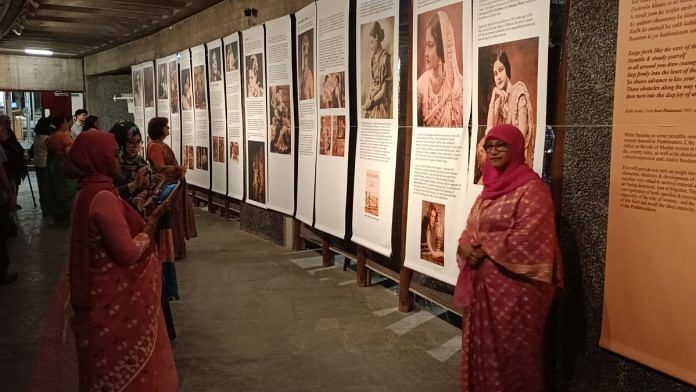New Delhi: From emerging as one of the first Indian voices to be heard on a gramophone to recording nearly 600 songs in 10 languages and spending thousands of rupees on her pet cat, Gauhar Jaan had many firsts to her credit. Her adventures and career in the early 1900s are now part of a life-size panel at the Quadrangle Garden of Delhi’s India International Centre.
Jaan is one among the 10 pioneering women of the Indian subcontinent whose contributions to the performing arts have been curated as part of the ‘Pathbreakers 2.0’ exhibition. Unveiled on 18 April and ending on the 26th, it is a collaboration between the Muslim Women’s Forum, Azadi ka Amrit Mahotsav and the Ministry of Culture.
“We wanted to showcase the industrious women — artistes, producers, singers, music composers and filmmakers – many of whom have been forgotten,” said Ranesh Ray and Sukhpreet Kahlon, the curators of Pathbreakers 2.0, in a joint statement.
Apart from Jaan, there are panels on India’s first female director and producer Fatma Begum and composers Ishrat Sultana and Jaddanbai Hussain. It also pays tribute to Begum Qudsia Zaidi, the force behind Hindustani Theatre – one of Independent India’s first urban professional theatre companies – and model-actor Jahanara Kajjan. The exhibition celebrates 10 trailblazing women at the forefront of India’s cultural revolution, six of whom were Muslim.
“Early stars like Jahanara Kajjan gained fame that transcended borders to reach Egypt, while Gauhar Jaan’s image on matchboxes was circulated in Austria. We’ve traced some sources of origins, spreads and patterns of migrations and ideas in this preview,” Kahlon told ThePrint.
Celebrating pathbreaking women
The exhibition takes the viewer back to the early 1920s and 1930s and gives us a peek into the lives of the women who broke the glass ceiling in their respective fields— Ruby Myers, better remembered as Sulochana, actor Durga Khote and dancer Azurie. A panel on Kamlabai Gokhale and her mother Durgabai Kamat showed how they created history by becoming the first women to be cast in an Indian film. Gokhale played the female lead, Mohini, in Dadasaheb Phalke’s 1913 film Mohini Bhasmasur while her mother played the role of Parvati. Until then, female roles were only essayed by male actors.
The exhibition is the second chapter of ‘Pathbreakers: The Twentieth Century Muslim Women of India’, which was inaugurated in 2018. It featured 22 Muslim women “who gave up the purdah on the eve of Independence and became partners in building a new India”. The archival exhibition featured Shareefa Hamid Ali, a founding member of the United Nations Commission on the Status of Women in 1947, and Surayya Tyabji, who contributed to the design of the national flag.
The second edition of Pathbreakers examines the influence women wielded across cultural centres in the Indian subcontinent — Benares, Lucknow, undivided Bengal and Punjab, Allahabad, Lahore, Karachi, Bombay and beyond. When art, music and dance coincided with India’s fight for Independence.
Also read:
A rich legacy
The 10 pioneers held their own at a time when society rebelled against the idea of women being a part of their milieu.
Gauhar Jaan, for instance, sang at the coronation of King George V at the Delhi Durbar in December 1911. Moreover, the singer – one of the first artistes to be recorded by the Gramophone Company of India – would sign off her recordings with the infamous ‘My name is Gauhar Jaan’.
Down in Patna, Kajjan, famed for her ‘knife dances’, also acted in theatre for Rs 250 per show. She then went on to feature in Shirin Farhad (1931), and Laila Majnu (1932) to become a favourite of the early talkies era.
Around the same time, Azurie made her presence felt in Bombay cinema through her love for dance and eventually became a key figure in the Calcutta film industry. She featured in multiple films as a dancer until 1947, when she married a Muslim naval officer and moved to Pakistan. There, she opened the first ‘Academy of Classical Dance’ in Rawalpindi, resisting violent opposition from the town’s maulvis (clerics).
The exhibition also brought to the fore the inherent connection between the courtesan culture that has been a part of the Indian subcontinent since the 16th century, and entertainment. These women were among the first to contribute to the post-Independence cinema emerging in Lahore and Bombay. Jaddanbai Hussain started as a classically trained singer and went on to open her own production company called Sangeet Films. She also introduced her daughter, the legendary Nargis, in Talashe Haq (1935) as a child actor.
People stopped to read the captivating panels on a balmy summer evening. For some, it was a reunion with old friends who entertained them on TV and radio. But for many, the exhibition was a discovery of the subcontinent’s rich cultural legacy. They posed in front of their favourite panels to have a keepsake of these trailblazers.
“I have barely heard of any of these women, and in today’s age, while we struggle over feminism, look at how they were so ahead of their times,” said Asma Sareen, a first-year student at the National Institute of Fashion Technology in Delhi, while slowly reading through each panel of the exhibition.
(Edited by Zoya Bhatti)



